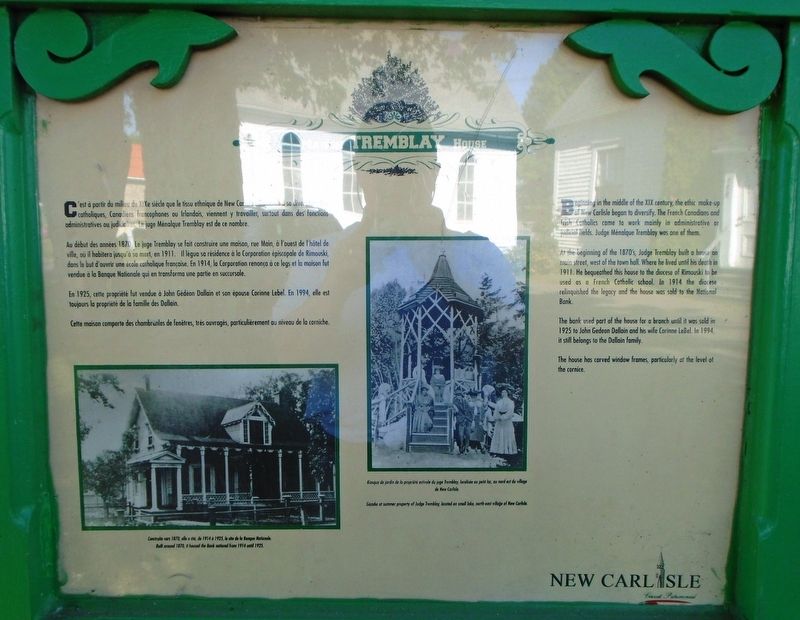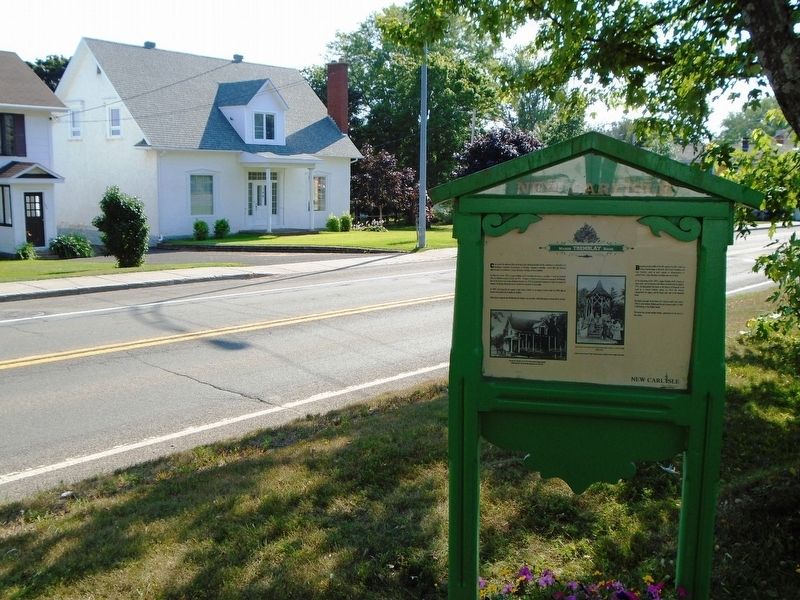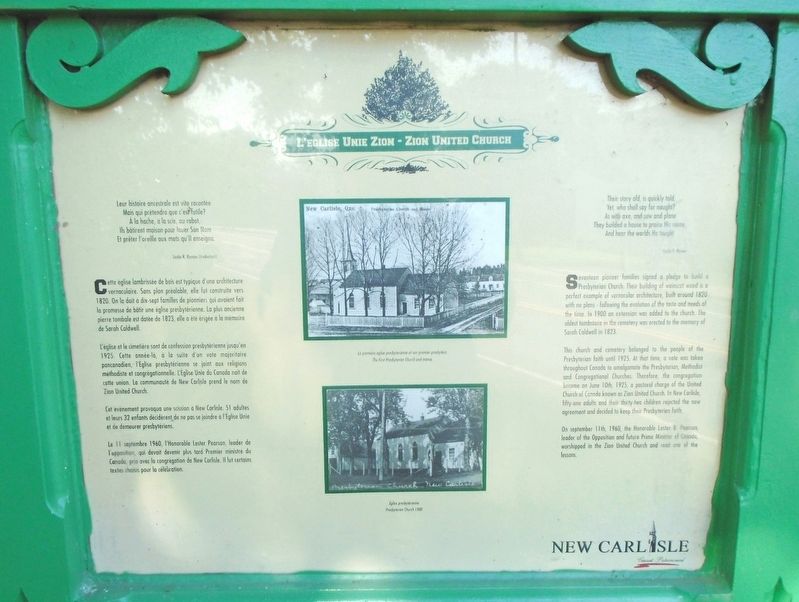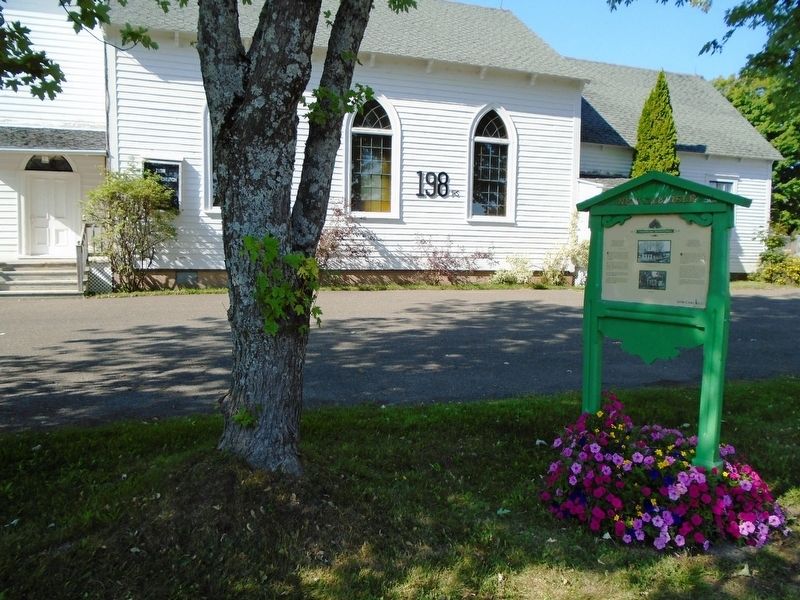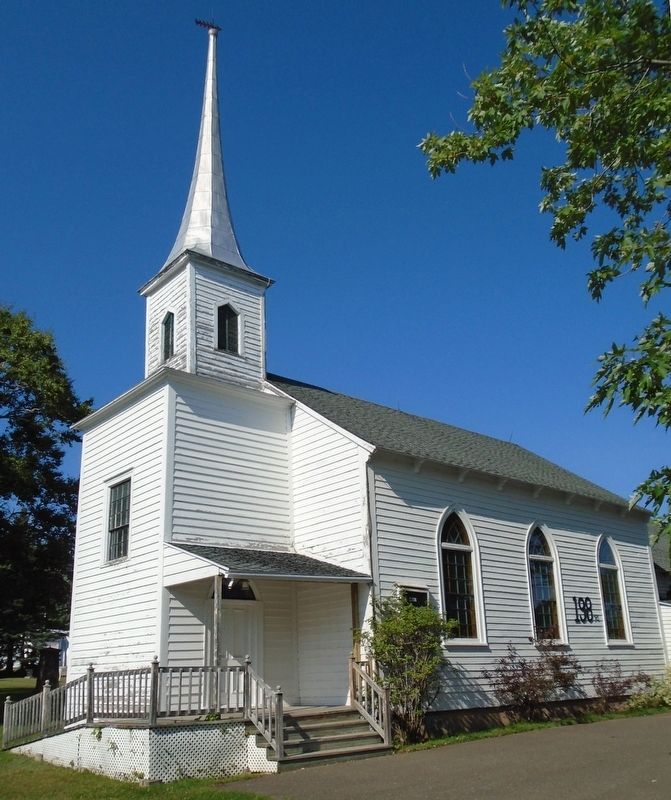Maison Tremblay House / L'eglise Unie Zion United Church
Circuit Patrimonial New Carlisle Heritage Circuit Stop 14
Maison Tremblay House
C'est à partir du milieu du XIXe siècle que le tissu ethnique de New Carlisle commence à se diversifier. Des catholiques, Canadiens francophones ou Irlandais, viennent y travailler, surtout dans des fonctions administratives ou judiciaires. Le juge Ménalque Tremblay est de ce nombre.
Au début des années 1870, Le juge Tremblay se fait construire une maison, rue Main, à l'ouest de l'hôtel de ville, où il habitera jusqu'à sa mort, en 1911. Il légua sa résidence à la Corporation épiscopale de Rimouski, dans le but d'ouvrir une école catholique française. En 1914, la Corporation renonça à ce legs et la maison fut vendue à la Banque Nationale qui en transforma une partie en succursale.
En 1925, cette propriété fut vendue à John Gédéon Dallain et son épouse Corinne Lebel. En 1994, elle est toujours la propriété de la famille des Dallain.
Cette maison comporte des chambranles de fenêtres, très ouvragés, particulièrement au niveau de la corniche.
[Légendes photo, de gauche à droite, lisez]
• Construite vers 1870, elle a été, de 1914 à 1925, le site de la Banque Nationale.
• Kiosque de jardin de la propriété estivale du juge Tremblay, localisée au petit lac, au nort-est du village de New Carlisle.
At the beginning of the 1870's, Judge Tremblay built a house on main street, west of the town hall[, w]here he lived until his death in 1911. He bequeathed this house to the diocese of Rimouski to be used as a French Catholic school. In 1914 the diocese relinquished the legacy and the house was sold to the National Bank.
The bank used part of the house for a branch until it was sold in 1925 to John Gedeon Dallain and his wife Corinne LeBel. In 1994, it still belongs to the Dallain family.
The house has carved window frames, particularly at the level of the cornice.
[Photo captions, from left to right, read]
• Built around 1870, it housed the [National Bank] from 1914 until 1925.
• Gazebo at summer property of Judge Tremblay, located on [a] small lake, north-east [of the] village of New Carlisle.
L'eglise
Cette église lambrissée de bois est typique d'une architecture vernaculaire. Sans plan préalable, elle fut construite vers 1820. On la doit à dix-sept familles de pionniers qui avaient fait la promesse de bâtir une église presbytérienne. La plus ancienne pierre tombale est datée de 1823, elle a été érigée à la mémoire de Sarah Caldwell.
L'église et le cimetière sont de confession presbytérienne jusqu'en 1925. Cette année-là, à la suite d'un vote majoritaire pancanadien, l'Église prebytérienne se joint aux religions méthodiste et congrégationnelle. L'Église Unie du Canada naît de cette union. La communauté de New Carlisle prend le nom de Zion United Church.
Cet événement provoqua une scission à New Carlisle, 51 adultes et leurs 32 enfants décidèrent de ne pas se joindre à l'Église Unie et de demeurer presbytériens.
Le 11 septembre 1960, l'Honorable Lester Pearson, leader de l'opposition, qui devait devenir plus tard Premier ministre du Canada, pria avec la congrégation de New Carlisle. Il lut certains textes choisis pour la célébration.
[Légendes photo, de haut en bas, lisez]
• Église presbytérienne 1900
Seventeen pioneer families signed a pledge to build a Presbyterian Church. Their building of wainscot wood is a perfect example of vernacular architecture, built around 1820 with no plans - following the evolution of the taste and needs of the time. In 1900 an extension was added to the church. The oldest tombstone in the cemetery was erected to the memory of Sarah Caldwell in 1823.
This church and cemetery belonged to the people of the Presbyterian faith until 1925. At that time, a vote was taken throughout Canada to amalgamate the Presbyterian, Methodist and Congregational Churches. Therefore, the congregation became on June 10th, 1925, a pastoral charge of the United Church of Canada known as Zion United Church. In New Carlisle, fifty-one adults and their thirty-two children rejected the new agreement and decided to keep their Presbyterian faith.
On
[Photo captions, from top to bottom, read]
• Presbyterian Church 1900
Mais qui prétendra que c'est futile?
À la hache, à la scie, au rabot,
Ils bâtiment maison pour louer Son Nom
Et prêter l'oreille aux mots qu'll enseigna.
Leslie R. Ramier (traduction)
• La première église presbytérienne et son premier presbytére.
Yet, who shall say for naught?
As with axe, and saw and plane
They builded a house to praise His name,
And hear the worlds He taught
Leslie R. Ramier
• The First Presbyterian Church and manse
Topics. This historical marker is listed in these topic lists: Churches & Religion • Industry & Commerce • Settlements & Settlers. A significant historical year for this entry is 1870.
Location. 48° 0.572′ N, 65° 19.746′ W. Marker is in New Carlisle, Québec, in Bonaventure. Marker is at the intersection of boulevard Gérard-D.-Levesque (Québec Route 132) and rue Réne-Lévesque, on the left when traveling east on boulevard Gérard-D.-Levesque. Touch for map. Marker is at or near this postal address: 139 boulevard Gérard-D-Levesque, New Carlisle QC G0C 1Z0, Canada. Touch for directions.
Other nearby markers. At least 7 other markers are within walking distance of this marker. L'eglise presbyterienne - Knox Presbyterian Church (within shouting distance of this marker); The Loyalist / Les Loyalistes (within shouting distance of this marker); La naissance de New Carlisle / Parc municipal (about 150 meters away, measured in a direct line); War Memorial (about 150 meters away); Légion Royale Canadienne / Palais de Justice
Also see . . . New Carlisle, Quebec: A Hidden Gem in Canada. Come Explore Canada website entry (Submitted on December 7, 2023, by Larry Gertner of New York, New York.)
Credits. This page was last revised on December 7, 2023. It was originally submitted on February 20, 2019, by William Fischer, Jr. of Scranton, Pennsylvania. This page has been viewed 186 times since then and 18 times this year. Photos: 1, 2, 3, 4, 5. submitted on February 20, 2019, by William Fischer, Jr. of Scranton, Pennsylvania.
